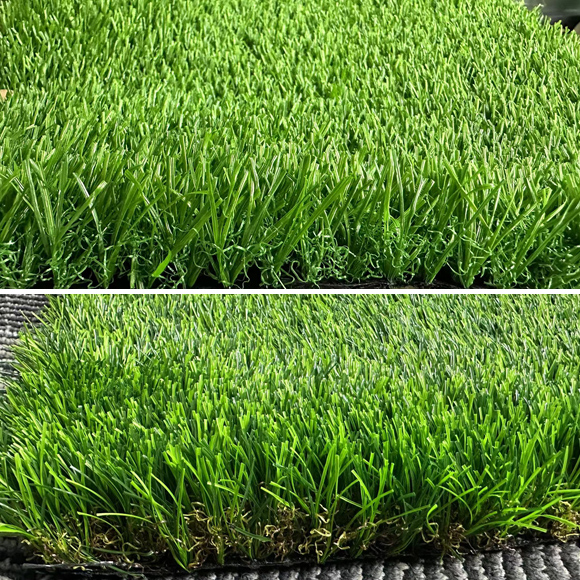
Budget-Friendly Artificial Grass Choices: The Cost-Effectiveness Analysis
In today's pursuit of greener environments and more comfortable lifestyles, artificial grass has become increasingly popular for residential yards, school playgrounds, commercial landscapes, and sports fields. With its low maintenance requirements, realistic appearance, and durability, it stands out as a versatile and practical choice. However, with the wide variety of options and prices available in the market, choosing the most cost-effective artificial grass can be challenging. This article delves into the cost structure, application scenarios, durability, and environmental benefits of artificial grass to help you make a smart, budget-friendly decision.
Cost Components of Artificial Grass
Before assessing the cost-effectiveness of artificial grass, it’s essential to understand its cost components. Typically, the total cost of artificial grass comprises the following elements:
1. Material Costs
- Grass Fiber Type: The main materials used in artificial grass are polypropylene (PP), polyethylene (PE), and, in premium products, nylon (PA). PE fibers are soft and realistic, ideal for residential and landscape applications; PP fibers are more cost-effective, suitable for sports fields; and nylon is highly durable but more expensive.
- Backing Material: High-quality artificial grass often features double-layered backing for enhanced strength and stability.
2. Installation Costs
Installation includes site preparation, grass laying, and bonding. If the ground is already leveled, installation costs will be lower. Otherwise, surface preparation will add to the expenses.
3. Maintenance Costs
Unlike natural grass, which requires watering, mowing, and fertilizing, artificial grass requires minimal maintenance, such as occasional cleaning, making it a cost-saving option in the long term.
4. Lifespan
High-quality artificial grass typically lasts 8–15 years. The longer the lifespan, the lower the cost per year of use, increasing its cost-effectiveness.
How to Evaluate the Cost-Effectiveness of Artificial Grass
1. Application Scenarios
Different scenarios demand different types of artificial grass. Here are some common applications and recommendations:
- Residential Yards: Opt for soft and realistic PE grass to enhance beauty and comfort.
- Children’s Play Areas: Prioritize safety and shock absorption with high-elasticity, impact-resistant grass.
- Sports Fields: Focus on wear resistance and drainage performance with high-density grass designed for sports.
- Commercial Landscapes: Choose grass with excellent UV resistance and realistic appearance.
2. Balancing Performance and Price
- Fiber Density and Height: High-density, long-fiber grass looks more realistic but costs more. Mid-density, medium-height grass can balance performance and budget.
- Durability: Choose materials with strong wear resistance and anti-aging properties. While they may have a higher upfront cost, they are more cost-effective in the long run.
- Brand Reputation: Established brands often provide higher quality products and better after-sales services, justifying a slightly higher price.
3. Long-Term Economics
Unlike natural grass, which incurs ongoing costs for watering, fertilizing, and mowing, artificial grass has negligible maintenance expenses, making it a more economical choice for budget-conscious buyers.
How to Achieve Budget-Friendly Artificial Grass Choices
1. Plan the Area Wisely
Before purchasing, measure the exact area to avoid overspending or material waste. For smaller areas, consider custom-sized options to save costs.
2. Buy in Bulk
For large-scale projects like school fields or commercial spaces, bulk purchases often come with discounts.
3. Choose the Right Installation Method
- DIY Installation: For small or simple areas, installing the grass yourself can reduce labor costs.
- Professional Installation: For complex projects or high-quality demands, hiring professionals ensures better installation quality and durability.
4. Look for Discounts and Promotions
Purchase during off-seasons or promotional events to secure better deals. Suppliers may also offer significant discounts on clearance or surplus inventory, providing excellent value.
Recommended High Cost-Effectiveness Artificial Grass Options
Based on market research, the following types of artificial grass are favored for their affordability and performance:
1. Mid-Density PE Grass: Ideal for residential and landscape use, offering softness and affordability.
2. Durable Sports Turf: Designed for sports fields, offering long lifespans and low maintenance costs.
3. Hybrid Fiber Grass: Combining PE and PP fibers for both softness and durability, striking a balance between cost and quality.
Type | Key Features | Applications | Advantages | Disadvantages | Price Range |
Mid-Density PE Grass | Soft, realistic, and weather-resistant | Yards, landscaping | Attractive appearance, cost-effective | Not suitable for high-frequency use | Moderate |
Mid-Density PE Grass | Strong wear resistance, excellent drainage, meets sports standards | Sports fields, stadiums | Long-lasting, low maintenance | lightly firm, less ideal for leisure | Moderate to High |
Elastic Turf for Children | Good elasticity and shock absorption, high safety | Play areas, kindergartens | Excellent safety and protection | Higher installation costs | Moderate |
Hybrid Fiber Grass | Combines PE softness and PP durability for versatility | Yards, public spaces | Balanced performance, versatile | Slightly higher price for some brands | Moderate to High |
Low-Density Budget Turf | Shorter fibers, lower density, basic design | Temporary displays, low-budget projects | Affordable, suitable for short-term use | Average appearance, less durable | Low |
Comparison Analysis
1. Best Cost-Effectiveness: Mid-Density PE Grass (ideal for residential and landscaping use).
2. Most Durable: High-Durability Sports Turf (ideal for high-intensity sports fields).
3. Highest Safety: Elastic Turf for Children (perfect for play areas).
4. Most Versatile Option: Hybrid Fiber Grass (combines softness and durability).
5. Most Budget-Friendly: Low-Density Budget Turf (ideal for temporary or less critical projects).
Depending on your specific needs and budget, you can select the most suitable type of artificial grass to ensure affordability while meeting your requirements.
When selecting artificial grass, evaluating cost-effectiveness requires careful consideration of budget, application scenarios, material performance, and long-term maintenance costs. By planning wisely and making informed decisions, you can enjoy the convenience and aesthetics of artificial grass while controlling expenses, achieving the ideal “one-time investment, long-term benefit” outcome.
Whether you’re creating a private garden retreat or designing a highly functional public space, artificial grass provides an economical, eco-friendly, and practical solution for modern living. If you’re seeking budget-friendly artificial grass options, we hope this guide helps you make the best choice!
![best quality artificial grass]()













